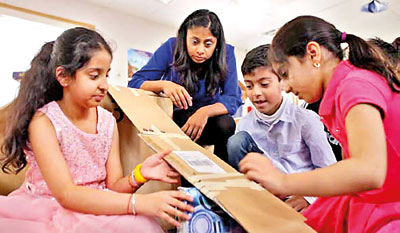Pandemic as a catalyst for change in our Education system
View(s):The pandemic has brought enormous disruption to the education of our youth during these two years. However, this may be a good opportunity for the academia and the educational authorities to consider a transformational shift in the delivery of the education, taking into consideration the need for children to lean the 21st century skills and practices that go beyond traditional content to include multidisciplinary skills such as problem-solving, critical thinking and creativity.
 As we all know, ‘why’ is a regularly used word by small children, as they are constantly engaged with observation and wonder.
As we all know, ‘why’ is a regularly used word by small children, as they are constantly engaged with observation and wonder.
Inquiry is part of their natural evolution. Educational experts are of the view that ‘Inquiry based learning’ is a highly effective method of learning as it is about triggering curiosity and thereby genuine engagement. Activating curiosity is a far more important goal than information delivery which can be considered as the traditional form of teaching. In the inquiry-based learning process, students themselves are the drivers of the learning process which ultimately results in the deeper understanding of a concept. This allows them to take responsibility for their own learning which enhances their commitment towards further exploration and knowledge.
Another tested method of learning is problem-based learning or context-based learning. Here, students solve or try to solve an authentic real-world problem through investigation, discovery, and engagement. Because of its meaningfulness and relevance, the students experience the value of their contributions and therefore it becomes an excellent form of learning. Problem-based learning motivates course content and maximizes learning through investigation, explanation and resolution and thereby encourages the development of practical skills and higher-order thinking.
Problem-based learning and inquiry-based learning are both student-centered teaching pedagogies that encourage active learning and critical thinking through investigation. In fact, problem-based learning can be classified as guided inquiry and therefore it is also a type of inquiry-based learning.
Common elements of inquiry and problem-solving include:
- Asking questions or defining problems
- Exploring solutions or explanations
- Analyzing or testing solutions or explanations
- Communicating possible solutions or explanations.

As an example, in mathematics when teaching about mutually exclusive and independent events in probability, the inquiry questions can be:
- What determines whether two events are independent?
- How does replacement in an experiment affect the type of event?
- How is the probability of success in a certain activity calculated?
- How accurate is the calculated probability of success in a human activity?
To enable such comprehensive skill learning, educational authorities need to invest in professional development to provide educators with the tools for its effective implementation. The groundwork that needs to be done include the following:
1. Identification of the aims and objectives of each subject
2. Developing and structuring courses to provide opportunities to meet the defined aims and objectives
3. Providing ideas and proposals to promote interdisciplinary learning
4. Preparation of guides and teacher support material to help teachers to plan the lessons according to the teaching & learning model to be followed
5. Preparation of clear assessment frameworks that can be followed by the teachers along withwell-defined grade descriptors.
Assessment is another important aspect that needs to be upgraded. The modern education trends inspire us to move towards criterion-based assessment instead of normative assessment. In normative assessment, the students are compared in relation to one another while in criterion-based assessment the students are assessed according to identified learning criteria. The dependence of a final grade wholly on a public examination has caused many difficulties to the students and examination boards during this pandemic. This might be the time to think about a hybrid assessment model comprising of internal and external evaluation of student work. The internal assessment can be in the form of a project or an exploration to be marked by the teachers according to identified criteria, while the external assessment is the common public examination that we are accustomed to.
If the will and determination are there, I feel that an inquiry-based learning model can be implemented in our local schools by the beginning of the year 2024. If all the material that are needed can be organized by the end of 2022, providing the much-needed professional development to the teachers can be completed in 2023. The success of the model depends primarily on the teachers.
The popular educational consultant Kath Murdoch said “Inquiry is not just knowing how to plan – it’s about how we teach. It’s about what we say to kids and how we say it.
It’s about the way we listen and the way we feel about what our kids are saying. It’s about knowing when to step back and when to step in. It’s about the language we use and the silences we deliberately leave. It’s about what we are thinking about what we are doing”.
R.N.A. de Silva
ndesilva@osc.lk
The writer is a senior examiner of the International Baccalaureate organization and member of the faculty of the Overseas School of Colombo.


